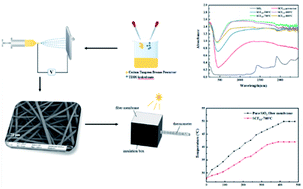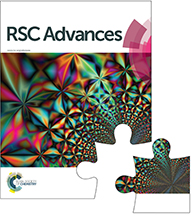Electrospinning preparation and near-infrared absorption properties of a silica/cesium tungsten bronze micro–nano fiber membrane
Abstract
Silica/cesium tungsten bronze (SiO2/CsxWO3) composite micro–nano fiber membranes were prepared by the co-precursor electrostatic spinning method using cesium chloride, tungsten powder and tetraethyl orthosilicate as raw materials. TGA, XRD, FT-IR, XPS, SEM and ultraviolet-visible-near red spectrophotometry were used to analyze the thermal decomposition process, phase composition, microscopic morphology and near-infrared absorption properties of the product. Studies have shown that as the ratio of Cs/W of raw materials increases, the crystallinity of CsxWO3 in the product increases first and then decreases. When n(Cs)/n(W) reaches 0.5, its crystallinity is the most complete; similarly, calcination also contributes to the crystallization of Cs0.33WO3, but high temperatures above 800 °C will also destroy its crystal structure. The study found that after calcination at 700 °C, the fiber membrane with a Cs/W atomic ratio of 0.5 has the best infrared absorption performance. The average absorbance of near-infrared light at 780–2500 nm is 1.5, which is 5.56 times that of the pure SiO2 fiber membrane. The tensile strength reaches 2.4 MPa, which can meet practical requirements. This research provides a basis for the development of flexible solar shading materials under complex outdoor conditions.



 Please wait while we load your content...
Please wait while we load your content...